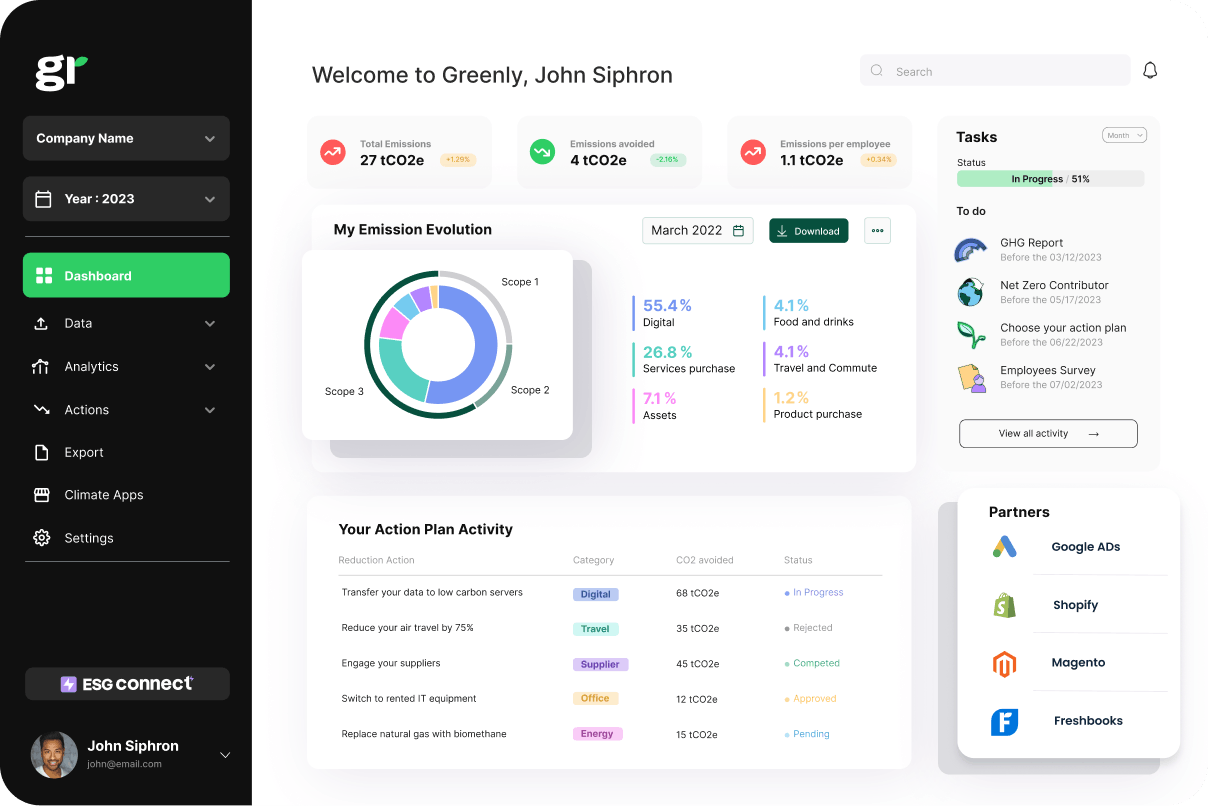
California Climate Accountability Package: SB253, SB261, & SB252
What is the California Climate Accountability Package, and how do SB 253 and SB 261 (SB 219), and SB 252 help the state work towards their environmental goals?
ESG / CSR
Industries



The business landscape is shifting. Companies today are under increasing pressure to adopt sustainable practices, engage meaningfully with stakeholders, and ensure ethical governance. But while Environmental, Social, and Governance (ESG) strategies have become a critical focus for businesses, knowing where to start can feel overwhelming.
Building an effective ESG strategy isn’t just about meeting stakeholder expectations - it’s about creating long-term value for your business while contributing to a more sustainable and equitable future.
👉 In this article, we’ll explore the key steps to develop an ESG strategy that not only meets global standards but also aligns with your company’s unique goals.
An ESG strategy outlines a company’s approach to managing its environmental, social, and governance responsibilities. It provides a framework for embedding sustainability and ethical practices into business operations, ensuring that the company addresses issues ranging from climate change to employee well-being and corporate transparency.
Rather than being a standalone initiative, an ESG strategy integrates with the overall business strategy, helping companies manage risks and seize opportunities. For example, prioritizing energy efficiency or sourcing sustainable materials can reduce costs while also meeting stakeholder expectations.
A good ESG strategy is proactive, transparent, and measurable. It considers the unique challenges of the business and its industry, setting clear goals that align with global standards like the UN Sustainable Development Goals (SDGs) or the Paris Agreement.
In short, an ESG strategy is a roadmap for building resilience, fostering trust, and driving positive change - both within and outside the organization.
In today’s market, a strong ESG strategy is no longer optional - it’s a business must-have. Companies that fail to act risk falling behind competitors, alienating stakeholders, and even facing regulatory penalties.
An effective ESG strategy offers numerous benefits, including:
Beyond these practical benefits, an ESG strategy enables companies to contribute to broader societal goals, such as combating climate change or promoting social equity. Businesses that embrace ESG are not just meeting expectations - they’re shaping a more sustainable future for everyone.
Creating an ESG strategy that drives meaningful change requires a structured and thoughtful approach. Whether you’re starting from scratch or refining existing efforts, these steps provide a roadmap for success:
Before setting goals, it’s essential to understand where your business currently stands. Start with a materiality assessment to determine the environmental, social, and governance issues most relevant to your operations and stakeholders.
A materiality assessment involves identifying the topics that have the greatest impact on your business and are most important to your stakeholders. This ensures your ESG strategy focuses on what truly matters.
Next, gather comprehensive data on your current performance. Key areas to assess include:
Creating a baseline will help you identify strengths, weaknesses, and opportunities for improvement. This step is also crucial for measuring progress over time.
ESG initiatives impact a wide range of stakeholders, from employees and investors to customers and local communities. A successful strategy depends on meaningful engagement with these groups to understand their priorities and expectations.
How to engage stakeholders effectively:
Engaging stakeholders not only ensures your strategy addresses real-world concerns but also builds trust and support for your initiatives.
Your ESG goals should be specific, measurable, achievable, relevant, and time-bound (SMART). Setting realistic yet ambitious targets ensures accountability while aligning with global standards like the UN Sustainable Development Goals (SDGs) or Science-Based Targets (SBTi).
Examples of ESG goals include:
Break these goals into measurable key performance indicators (KPIs) to track progress. KPIs provide clarity on what success looks like and help demonstrate accountability to stakeholders.
An ESG strategy is only as effective as the plan that supports it. Once you’ve set your goals, outline the specific steps needed to achieve them.
Key elements of an actionable plan:
For example, if one of your goals is to reduce emissions, your plan might include:
The key is to integrate ESG initiatives into everyday business operations, making sustainability a core part of your company’s identity.
Transparency is critical for building trust with stakeholders and maintaining accountability. Communicate your ESG strategy and progress both internally and externally.
Internal communication:
External communication:
Clear and consistent communication ensures stakeholders stay informed and engaged with your ESG journey.
Developing an ESG strategy is not a one-time exercise - it’s an ongoing process. Regularly monitor your progress, evaluate your performance against KPIs, and adapt to changes in regulations or stakeholder expectations.
How to monitor and improve effectively:
For example, if new regulations require stricter emissions reporting, update your monitoring processes to ensure compliance. Similarly, if a stakeholder survey reveals dissatisfaction with your social initiatives, consider refining your approach.
By staying flexible and proactive, your business can ensure its ESG strategy remains impactful, credible, and aligned with evolving expectations.
While developing an ESG strategy is essential, it’s not without its challenges. Many businesses encounter obstacles that can slow progress or make implementation more complex. Here are some common challenges and how to address them:
| Challenge | Details | Solution |
|---|---|---|
| Limited resources | Small and medium-sized businesses often lack the time, money, or personnel to dedicate to ESG efforts. | Start small by focusing on high-impact areas and scale up over time. Use tools like Greenly's platform to streamline processes and reduce costs. |
| Data gaps | Gathering accurate data, especially for Scope 3 emissions and supply chain activities, can be difficult. | Leverage technology and partnerships to bridge data gaps. Use platforms specializing in ESG metrics to monitor performance effectively. |
| Resistance to change | Employees or leadership may resist ESG efforts due to uncertainty about long-term benefits or misaligned priorities. | Educate and communicate with employees and leadership. Show how ESG initiatives align with company goals and highlight the business case for sustainability. |
| Evolving regulations | Constant updates to ESG reporting requirements can make compliance challenging for businesses. | Stay informed about regulatory updates and partner with ESG compliance experts to keep your strategy current. |
| Measuring impact | Quantifying the impact of ESG initiatives, particularly social or biodiversity improvements, is often challenging. | Develop clear KPIs and use recognized frameworks to standardize measurement. Seek third-party certifications for external validation. |
Developing a robust ESG strategy can feel overwhelming, but established frameworks and standards offer a valuable starting point. These tools provide guidance on structuring your approach, setting goals, and reporting progress. Here are some of the most widely recognized ESG frameworks and standards:
The GRI is one of the most commonly used frameworks for ESG reporting. It provides detailed guidelines for companies to disclose their environmental, social, and governance impacts. The GRI’s comprehensive structure helps organizations identify material issues, track progress, and communicate their performance transparently.
Why it matters: GRI standards are widely recognized, making them an excellent choice for businesses looking to build credibility with stakeholders.
SASB focuses on industry-specific sustainability metrics, making it highly relevant for companies operating in sectors with unique challenges. It provides a set of standards tailored to 77 industries, covering material ESG topics most likely to impact financial performance.
Why it matters: SASB standards help businesses align ESG efforts with financial objectives, making it easier to communicate value to investors.
The TCFD framework for reporting climate-related risks and opportunities has been transferred to the ISSB (IFRS S1 and S2). In October 2023, the TCFD was disbanded, and its recommendations were incorporated into the ISSB standards, which now provide a global baseline for climate-related disclosures. These standards emphasize governance, strategy, risk management, and metrics related to climate.
Why it matters: ISSB standards, built on TCFD principles, are increasingly favored by investors and regulators. Companies aligning with these standards can effectively address climate-related risks while meeting evolving disclosure expectations.
The UN SDGs offer a global blueprint for addressing pressing environmental, social, and economic challenges. While not specifically a reporting framework, the 17 goals provide a valuable reference for companies aligning their ESG strategies with broader sustainability objectives.
Why it matters: The SDGs highlight the global impact of your ESG initiatives and connect your strategy to widely recognized priorities like gender equality, clean energy, and climate action
ISO (International Organization for Standardization) offers various standards relevant to ESG, such as ISO 14001 for environmental management systems or ISO 26000 for social responsibility. These standards provide practical guidelines for integrating ESG principles into business operations.
Why it matters: ISO standards are known for their focus on operational excellence and continuous improvement, making them ideal for embedding ESG into day-to-day practices.
Using these frameworks can help companies structure their ESG strategies effectively, ensuring alignment with global best practices and boosting stakeholder confidence. While no single framework fits every business, combining elements from multiple standards can provide a comprehensive approach tailored to your company’s needs.
Developing an ESG strategy is a complex process, but you don’t have to navigate it alone. Greenly’s expertise in carbon management and sustainability reporting makes it the ideal partner for businesses looking to build or enhance their ESG strategies.
Here’s how Greenly can support your journey:
By combining advanced technology with personalized support, Greenly makes sustainability actionable and achievable for companies of all sizes. Whether you’re just starting your ESG journey or looking to refine your strategy, Greenly is here to help. Get in touch with us today.
